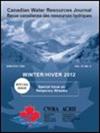农村供水非均质含水层安全产量估算的死后分析
IF 0.9
4区 环境科学与生态学
Q3 WATER RESOURCES
引用次数: 0
摘要
摘要可持续地下水管理建立在对取水对含水层水位以及接受地下水排放的泉水和溪流的影响的正确理解之上。抽水试验数据通常用于开采许可证申请,以评估含水层特性并评估抽水造成的蓄水损耗程度。但是,持续时间短(例如48 小时)抽水试验可能无法检测到含水层边界的存在,因为凹陷的锥体不够大,无法到达边界。这可能会导致对长期开采量的低估和对允许开采率(即安全产量)的高估。在阿尔伯塔省的Irricana农村城镇,根据对48小时抽水试验的分析,市政供水井的地下水开采许可证于20世纪80年代初颁发。实际的取水率大大低于许可的取水率,但蓄水层意外的过度水位下降迫使该镇在25日后停止抽水并改用地表水供应 年。为了检查过度分配的原因,在同一含水层中进行了一项新的48小时抽水试验,其中包括使用26 天的恢复数据。Irricana周围地区现有井的地质地层日志用于推断非均质基岩地层中砂岩含水层单元的范围。新的数据分析表明,含水层是半封闭的,这与原始抽水试验中使用的无限含水层假设相反,该假设由于含水层边界效应而导致额外的水位下降。这项研究提出了一种使用标准水文地质方法和现成数据估计储存损耗的改进程序。作为适应性地下水管理的一部分,新程序提供了一个有用的工具,其中监测水位和其他相关变量,并相应调整许可开采率。本文章由计算机程序翻译,如有差异,请以英文原文为准。
Postmortem analysis of safe-yield estimation of a heterogeneous aquifer for rural water supply
Abstract Sustainable groundwater management is founded on the sound understanding of the effects of water extraction on the aquifer water level and the springs and streams receiving groundwater discharge. Pumping test data are commonly used in extraction licence applications to evaluate aquifer properties and assess the magnitude of storage depletion resulting from pumping. However, a short duration (eg 48 hours) pumping test can fail to detect the presence of aquifer boundaries, as the cone of depression is not large enough to reach the boundaries. This may cause an underestimation of long-term drawdown and an overestimation of permissible extraction rate (ie safe yield). In the rural town of Irricana in Alberta, groundwater extraction licences for municipal water supply wells were issued in the early 1980s based on the analysis of 48-hour pumping tests. Actual water extraction rates were substantially below the licensed rates, but the unanticipated and excessive drawdown in the aquifer forced the town to discontinue pumping and switch to surface water supply after 25 years. To examine the cause of overallocation, a new 48-hour pumping test was conducted in the same aquifer, which included an extended drawdown analysis using 26 days of recovery data. Geological formation logs for existing wells in the area surrounding Irricana were used to infer the extent of sandstone aquifer units within the heterogeneous bedrock formation. The new data analysis showed that the aquifer is semi-closed, contrary to the infinite-aquifer assumption used in the original pumping test, which caused additional drawdown due to the aquifer boundary effects. This study suggests an improved procedure for estimation of storage depletion using standard hydrogeological methods and readily available data. The new procedure provides a useful tool as part of adaptive groundwater management, in which water levels and other relevant variables are monitored and licensed extraction rates are adjusted accordingly.
求助全文
通过发布文献求助,成功后即可免费获取论文全文。
去求助
来源期刊

Canadian Water Resources Journal
WATER RESOURCES-
CiteScore
2.90
自引率
5.90%
发文量
17
审稿时长
>12 weeks
期刊介绍:
The Canadian Water Resources Journal accepts manuscripts in English or French and publishes abstracts in both official languages. Preference is given to manuscripts focusing on science and policy aspects of Canadian water management. Specifically, manuscripts should stimulate public awareness and understanding of Canada''s water resources, encourage recognition of the high priority of water as a resource, and provide new or increased knowledge on some aspect of Canada''s water.
The Canadian Water Resources Journal was first published in the fall of 1976 and it has grown in stature to be recognized as a quality and important publication in the water resources field.
 求助内容:
求助内容: 应助结果提醒方式:
应助结果提醒方式:


